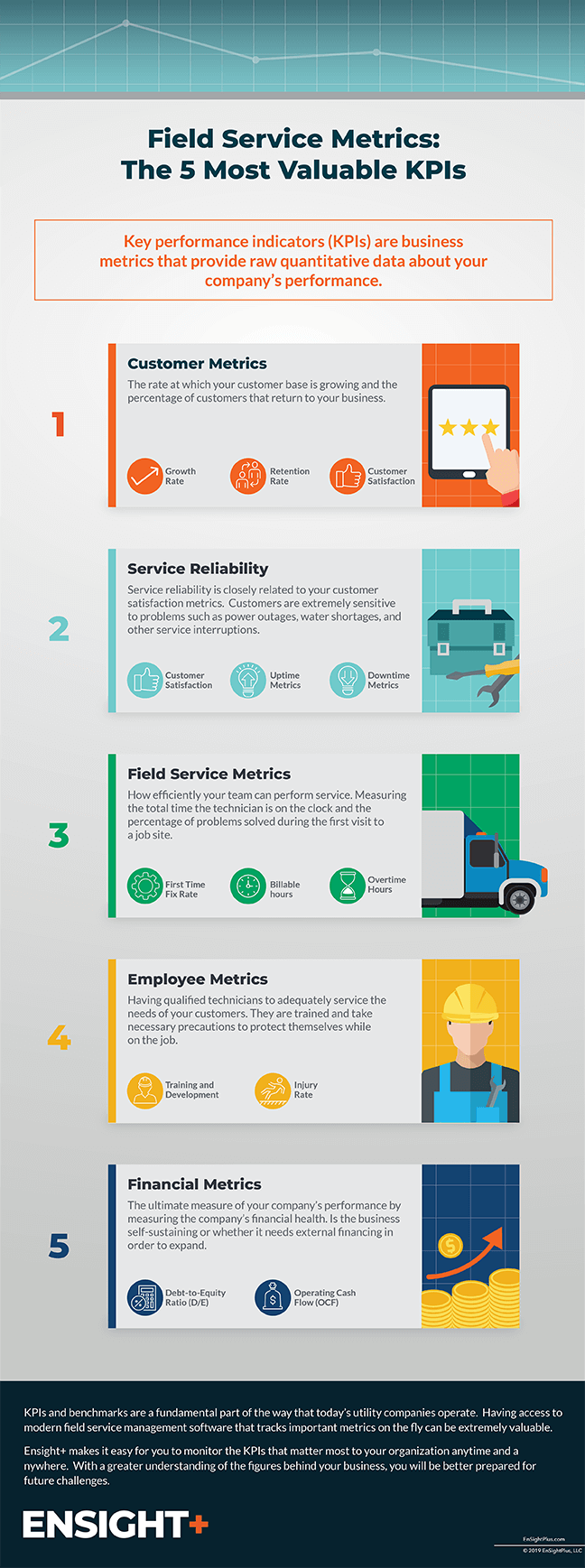Key performance indicators (KPIs) are business metrics that provide raw quantitative data about your company’s performance. Unfortunately, too many field service professionals are leaving valuable insights on the table and making decisions based on inaccurate assumptions.
Without using KPIs to measure your company’s performance, it will be difficult to measure how well you’re fulfilling organizational needs and objectives.
You can chart your course and measure success by capturing verifiable data about business performance. Without using KPIs to measure your company’s performance, it will be near impossible to measure how well you’re fulfilling organizational needs.
Utility companies should keep a close eye on their KPIs in order to keep operations on track and better serve their customers. As the demand for utilities continues to increase, businesses need to handle the necessary rise in production while also improving their efficiency and productivity metrics.
In this article, we will discuss 5 of the most important KPIs that field managers should monitor to keep their projects on time and under budget.

Problems with customer metrics are an early sign that something needs to change operationally. Two of the most important customer KPIs are:
These metrics are similar but don’t precisely measure the same information. Even if your customer base is growing, for example, you could be seeing high levels of customer churn that are hurting your bottom line. This likely indicates that there’s room to improve on how you retain new customers.
Keep in mind, customer metrics are important because many customers choose to “vote with their feet”. Although they may not communicate their dissatisfaction directly to you, customers will depart your business if they are not pleased with the service they have received.
Customers are extremely sensitive to problems such as power outages, water shortages, and other service interruptions. Because of this, service reliability is closely related to your customer satisfaction KPIs.
Service uptime and downtime metrics can have a major impact on how customers perceive the quality of your business. Electric power companies use indices such as SAIDI (Service Average Interruption Duration Index) and SAIFI (Service Average Interruption Frequency Index) to assess how often their system experiences downtime.
Once an outage occurs, you need to act fast. The measure of how efficiently your team can perform service is another important KPI for utility companies and contractors alike.
The KPIs in this category may include:
You need the right technicians and support staff to adequately service your customers. Two of the most relevant employee KPIs are:
Financial metrics are the ultimate measure of your company’s performance because they are so heavily dependent on the other four KPI categories listed above. One important metric of a company’s financial health is its debt-to-equity ratio (D/E). This calculates the shareholders’ equity as compared to the debt that the company takes on to finance its assets.
Another important financial KPI is your operating cash flow (OCF), which measures the amount of cash generated during your normal business operations. OCF can help determine whether your business is self-sustaining or whether it needs external financing in order to expand.
Key Performance Indicators (KPIs) and benchmarks are a fundamental part of the way that today’s utility companies operate. Having access to modern field service management software that tracks important metrics on the fly can be extremely valuable.
EnSight Plus Field Service Software makes it easy for you to monitor the KPIs that matter most to your organization. Prepare for future challenges with a clearer understanding of the figures behind your business.